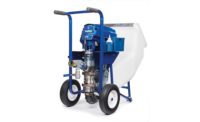Four Tips for Mixing and Pumping Field-Mixed Stucco Basecoats

When preparing to pump stucco basecoats, the right mix can make all the difference. Fiber reinforced cement basecoat consists of an 80 pound (lb.) bag of concentrated cement mixed with 200-240 lbs. of washed sand certified to American Society for Testing and Materials (ASTM) standard C897 or C144, and potable water.
Many manufacturers offer proprietary “pump grade” mixes which contain a greater proportion of lime, a workability agent added to mortar mixes. These proprietary mixes are ideal for providing better pumpability and better product on the wall, and are highly recommended if available. Manufacturers do not always have pump grade mixes available, though, so field mixes are sometimes needed. To help ensure smooth pumping and avoid pack-outs, follow these guidelines to prepare the mix.
Key Tips for Field-Mixing
1. Using the right sand. Be sure to start with sand that meets the appropriate ASTM gradations. If rocks over ¼ inch (in.) in diameter are present, whether from the incorrect grade of sand or because the delivery truck was not cleared of debris before loading the sand, the material may pack-out in the pump, delivery hose or application nozzle.
2. Getting the mix right. Many pumps will not efficiently move mortars that approach or exceed the recommended amount of sand. Pump pack-outs usually start when the mix contains too much sand or there is not enough water in the mix. The key to adding the correct amount of sand is to start at 75 percent of the recommended sand for the mix, and then slowly increase as-needed. Water content in mixing mortar is also important for creating a mix that is workable for both pumpability and wall applications.
When starting operations for the day, mix the material slightly wetter than normal for the first batch and then gradually add more sand to subsequent batches until the recommended limit is reached or the pump no longer moves efficiently. If the pump packs out while slowly increasing sand, you’ll know how much sand is too much for future batches. In case of a pack-out while mixing, reduce the amount of sand and increase water to richen the mix and try to pump any suspect material out of the hose before resuming pumping operations.
Adding a few handfuls of lime to the mix will also help improve the workability and pumpability of the mortar.
3. Optimize pumpability throughout the day. Once the optimal amount of sand for ideal pumpability has been reached, it is important to stay consistent throughout the day. Keep an eye on your mix throughout the day and be prepared to add/reduce sand or water to keep the mix consistent as you pump.
4. Preparing the pump. Before you can start pumping for the day, the hose must be completely wetted out. Ideally, run a slurry of lime and water through the hose to lubricate it before pumping begins. If lime is not available, use water alone. If you try to pump before wetting out the hose, the dry hose will absorb the water from the mix and pack-out immediately. Once the hose has been wetted out, pump the mortar through the hose until it reaches the end. Install the application nozzle and then adjust the pump speed/air ratio to obtain a consistent spray pattern.
Just as you must wet the hose before pumping, it is important to clean the hose right after pumping is completed for the day. If not cleaned quickly, the cement will dry in the hose, rendering it unusable.
In addition to preparing the mix and pump properly, consider the diameter and layout of the hose. The larger the diameter of the pump hose, the less work the pump has to do. Avoid using a hose smaller than 1 ¼ in. when pumping field mixes. Ideally, start with a 1 ½ in. hose with a 1 ¼ in. section for the nozzle.
If you have excess hose on your job site, avoid laying the hose in loops, as they create a significant amount of back pressure and can create kinks in the hose as it is pulled while the pump is running. Instead, lay the hose on the ground in an S-pattern to keep the mortar moving.
If a pump grade mix is not available for your job, adhering to these guidelines when mixing your basecoat in the field will help get the job done faster and with fewer stops.
For more information about pumping field-mixed stucco basecoats, visit graco.com/toughtek.
Looking for a reprint of this article?
From high-res PDFs to custom plaques, order your copy today!





